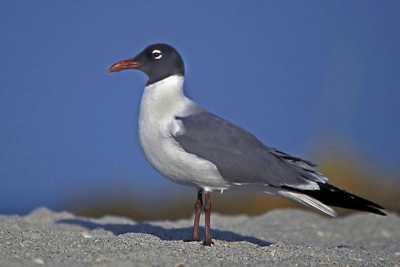 SKC Films Library SKC Films Library |
| SKC Films Library >> Science >> Zoology >> Birds >> Order Charadriiformes |
| Laughing Gull Larus atricilla
Decription Named for its characteristic "laughing" call, this gull is also distinguished from other gulls during the breeding season by a black cap with narrow white crescents around the eyes. In winter, the cap becomes a blurry gray mask on a white head. The legs are reddish black to black. As a juvenile, the laughing gull has a complete tail band, gray wash on the nape, dark brown wings, and a brown head and body. It takes 2-3 years for the laughing gull to gain adult plumage, during which time it will undergo several moults. Adult laughing gulls are 15-18 inches long, have a wingspan of 40-42 inches, and weigh 0.5-1 pound. Distribution and Habitat In the summer, the laughing gull breeds along the northeastern coast of America, before migrating southwards to Central America and the northern coasts of South America. It is found year-round in the Caribbean, and is an occasional visitor to much of Europe and Australia. Generally found only in coastal regions, especially around beaches and salt marshes, laughing gulls have been known to range several miles inland to rivers, fields, and dumps. They are also found well inland in Florida and at the Salton Sea in Southern California. Reproduction Laughing gulls breed from late April to late May, with those in the south breeding earlier than those in the north. Males arrive at the breeding grounds about a month before the females in order to establish territories and nesting sites. Upon arrival of the females, the males begin courting females with displays and offerings of fish, and this courtship may last for up to two weeks. They breed in colonies, sometimes with thousands of nests, and sometimes associated with other species of gulls or terns. Laughing gulls nest on beaches and dredge spoil islands among grass and bushes. The nest, which is built by both sexes, may be a scrape in ground with sparse lining or a shallow cup of grass, sticks, and debris, lined with finer grass. The adults may continue adding to the nest during incubation. Up to four olive to buff or brown, blotched with brown, eggs may be laid, but the average clutch size is three. They are incubated by both parents for up to 28 days. The young remain in the nest for a few days after hatching, then wander nearby, hiding under vegetation. Both parents feed the young, giving them half-digested food at first, solid food later. Age at first flight is about five weeks. Diet Like most other gulls, the laughing gull is an opportunistic feeder. It will forage while walking, wading, swimming, and in flight, gathers at rubbish dumps to feed on scraps, follows tractors to catch disturbed insects, and follows fishing boats to feed on discards. It is also known to steal food from brown pelicans, landing on the pelican's head and literally snatching fish from its bill pouch. Scientific Classification Phylum Chordata SOURCES |
| SKC Films Library
>> Science
>> Zoology >> Birds >> Order Charadriiformes This page was last updated on June 16, 2017. |
